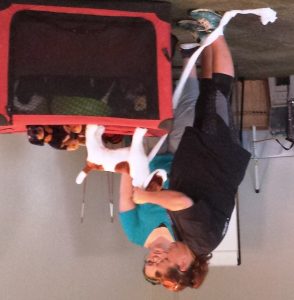Report from PPG’s Four-Day Pet Care Technician Certification Program Workshop (Part Eight of Eight)

Rebekah King (left) teaches Sally Saxton how to correctly lift a large dog
This is the final post in a series of eight blogs in which we will share a few of the highlights from the PPG workshop which covered all the necessary skills needed to become a Certified Pet Care Technician (CPCT).
The last day seemed to arrive very quickly. Day four meant Rebekah King and the PPG Pet First Aid course. King began by telling the attendees exactly what pet first aid is and how we should handle an animal during an emergency situation. Obviously we need to make sure everyone is safe and so King demonstrated how to apply an emergency muzzle. All of the attendees then had the opportunity to practise using a piece of gauze as an emergency muzzle.

Practicing applying an emergency muzzle
The first step of making a muzzle is to make a loop with a piece of gauze (or a nylon leash or similar item) using a simple knot as if you were tying a shoe lace. The loop should then be placed over the dog’s nose with the ‘knot’ under the chin. King stressed the need to make sure that the knot of the emergency muzzle is placed below the dog’s muzzle and not on top, as that would mean that the straps going around the dog’s neck could inadvertently scratch the dog’s eyes – the two lengths would go straight over the eyes when you fasten around the head! The material or your nails could then scratch the dog’s eyes and they would also probably suffer a negative response at not being able to see. The muzzle loop is then tightened, making sure the dog’s tongue is inside the mouth and the two lengths of gauze are tied in a bow at the back of the dog’s head. Tying in a bow ensures that the muzzle can be quickly released if necessary. King stressed that an emergency muzzle is just that – for an emergency- and should not be left on a dog for a prolonged period of time. A dog suffering from any problems with his breathing should not be muzzled.
There are many examples of how to make a temporary muzzle online but, unfortunately, many erroneously leave the knot on top on top of the muzzle! Fortunately for us all, Tawzer Dog were on hand to film the workshop and the CPCT DVD will soon be available for purchase. This will mean you can do the entire course from the comfort of your living room!
The presentation continued with an incredible amount of information, videos, demonstrations and practical exercises. Everything from checking a pulse, to capillary refill time, to taking a temperature. The first-aid course covered all of the common emergencies you might see: Shock – the early signs of which are often missed; heat stroke – the brachycephalic breeds such as English Bulldogs, Pugs and Boston Terriers are especially at risk; lacerations and wounds – some may be superficial but others could be deep, including tendons or muscles; bandaging; cat bites and scratches – cats carry a bacteria commonly known as Pasteurella in their mouths which can result in cellulitis, septicemia, septic arthritis and even permanent damage if they bite a human; hot spots; broken toenails; burns – chemical, electrical, thermal; corneal abrasions and ulcers; prolapsed eye – can occur after a jolt or blunt trauma that dislodges the eyeball; fractures ; luxation (dislocation) – usually affect hip, elbow or shoulder but could affect any joint; hypoglycemia; choke – animal will paw at face and be panic stricken; gastro-intestinal foreign body – very common in puppies or kittens; gastro–distention and Volvulus (bloat); toxicities; insect bites or stings; snake bites; dehydration; vomiting; diarrhea; seizures; CPR – Cardio Pulmonary Resuscitation – Circulation, airway, breathing – No femoral pulse, can’t feel heartrate? Start compressions!

If you would like to know more about pet care, why not sign up for The Pet Professional Guild’s Virtual Pet Care Summit taking place on Thursday, August 11 and Friday, August 12, 2016 ? There will be more than 25 hours of educational webinars across a variety of topics geared towards the pet care professional! More information and online registration here.
